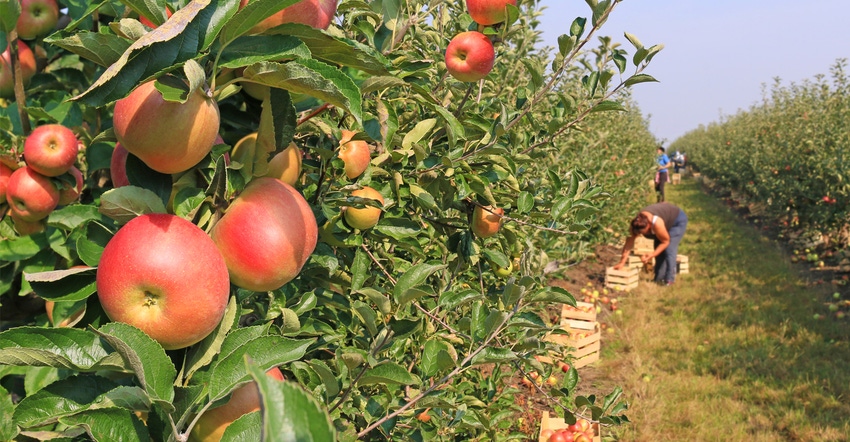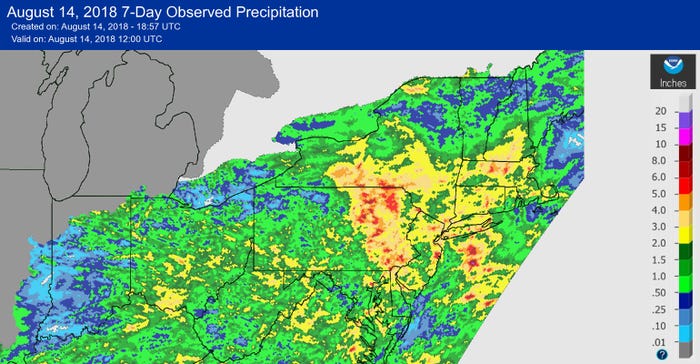
"Too much rain!" That was Scott Overdorff's sentiment from Indiana County, Pa., in the latest USDA Crop Progress Report released on Monday.
It's been a rainy summer indeed. From Aug 6-13, the reporting period, another 2 to 5 inches of rain fell in eastern Pennsylvania, south-central New York, parts of New Jersey and southern New England, and northern Delaware and Maryland's Eastern Shore, according to the National Weather Service.
Judy A. Behney, a reporter for the Pennsylvania Crop Progress Report in Adams County, says the heavy rains have led to poor field crop stands in the county. In the Pennsylvania "fruit belt," the heavy rains are starting to take their toll on apples and peaches, she says, as "producers [are] trying to do what they can to be able to harvest fruit to sell."
Most crops in the report are in good shape, with 93% of corn silking, 56% in the dough stage and 8% dented. Soybeans are a little behind with 62% of the crop in bloom, which is short of the 87% five-year average.
Meanwhile, peaches and apples are falling behind. Thirty-four percent of peaches have been harvested, behind the five-year average of 57%. Only 7% of apples have been harvested, behind the five-year average of 21%.

'Poor' looking corn in Maryland and Delaware
The combined Crop Progress Report for Maryland and Delaware is not good for corn and soybeans. While Maryland corn is on track in terms of its growth stage, the crop is rated 24% "poor" and 43% "fair." Very little of the crop is rated "excellent."
Soybeans blooming are at 48%, behind the five-year average of 75%. Only 22% of the beans have set pods, behind the five-year average of 55%.
Delaware corn is in worse shape with 27% of the crop in poor condition. The amount of corn in the dough stage is 23%, behind the five-year average of 65%. Soybeans setting pods is 23%, behind the five-year average of 51%. Thirty-one percent of tomatoes have been harvested, behind the five-year average of 56%.
Empire crops turns a corner
I was at a farm event last week in the Finger Lakes and I can't tell you the number of people who were thrilled with the rain that fell. After a really dry start to the growing season, the state's corn crop is starting to catch up and is in good shape, according to the Crop Progress Report. The soybean bloom, at 80%, is well-ahead of last year's pace of 51% at this time. Fifty-one percent of soybeans are setting pods, also well-ahead of last year's pace.
Still, areas of "moderate" drought can be found in the North Country and in the Niagara region of northwest New York. It is "abnormally dry" across Long Island, according to the U.S. Drought Monitor.

Moderate drought in Vermont
The area of moderate drought goes from central Vermont all the way to the Canadian border.
In neighboring New Hampshire, rain has been spotty.
"Topsoils in the southwestern corner of the county (Lebanon area) received the most rain. Topsoils in that area are saturated. Soils in the central western area along the Connecticut River are still deficient," says reporter Steven Schmidt in Grafton. "The hay crop is beginning to show some indications of recovery, but there is still a significant reduction in hay yields due to the extremely dry conditions from earlier in the spring and summer. The corn crop appears to be doing better as the season progresses. Corn has tasseled, and rains arrived at the right time to help ear development along."
Areas of moderate drought are also found along coastal Maine.
About the Author(s)
You May Also Like






